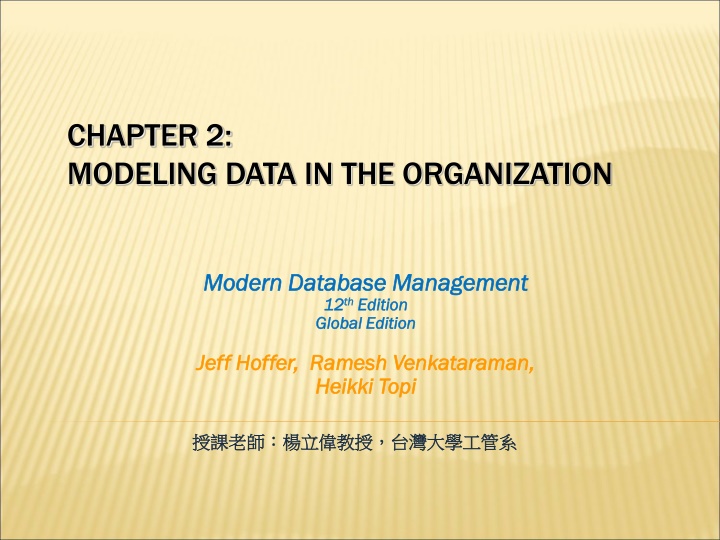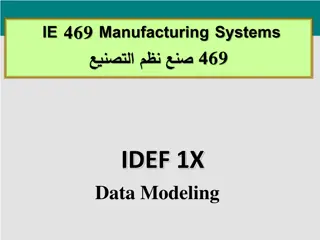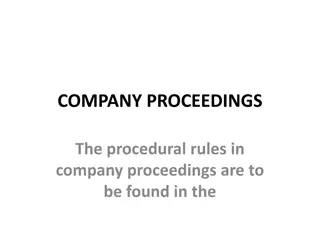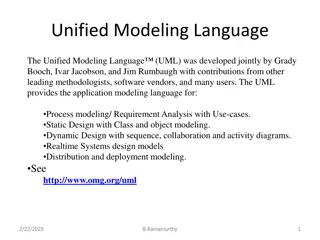Modeling Data in the Organization: E-R Model Constructs and Business Rules
This content delves into the fundamental concepts of modeling data in organizations, focusing on E-R model constructs such as entities, relationships, and attributes. It explores the significance of business rules in defining and constraining aspects of a business, emphasizing characteristics of good business rules and their automation through DBMS software. The material includes examples of E-R diagrams and basic notations, as well as guidelines for creating effective data names that are business-oriented and meaningful.
Download Presentation

Please find below an Image/Link to download the presentation.
The content on the website is provided AS IS for your information and personal use only. It may not be sold, licensed, or shared on other websites without obtaining consent from the author.If you encounter any issues during the download, it is possible that the publisher has removed the file from their server.
You are allowed to download the files provided on this website for personal or commercial use, subject to the condition that they are used lawfully. All files are the property of their respective owners.
The content on the website is provided AS IS for your information and personal use only. It may not be sold, licensed, or shared on other websites without obtaining consent from the author.
E N D
Presentation Transcript
CHAPTER 2: MODELING DATA IN THE ORGANIZATION Modern Database Management Modern Database Management 12 12th thEdition Edition Global Edition Global Edition Jeff Jeff Hoffer Hoffer, , Ramesh Ramesh Venkataraman Venkataraman, , Heikki Heikki Topi Topi
E-R MODEL CONSTRUCTS Entities: Entity instance person, place, object, event, concept (often corresponds to a row in a table) Entity Type collection of entities (often corresponds to a table) Relationships: Relationship instance link between entities (corresponds to primary key-foreign key equivalencies in related tables) Relationship type category of relationship link between entity types Attributes: Properties or characteristics of an entity or relationship type (often corresponds to a field in a table) Chapter 2 2-2
Sample E-R Diagram (Figure 2-1) 1 0 or 1 1 N 0 N Chapter 2 2-3
Basic E-R notation (Figure 2-2) Entity symbols Attribute symbols A special entity that is also a relationship Relationship symbols Relationship degrees specify number of entity types involved Relationship cardinalities specify how many of each entity type is allowed Chapter 2 2-4
BUSINESS RULES Are statements that define or constrain some aspect of the business : Ex. 30 Are derived from policies, procedures, events, functions; Assert business structure Control/influence business behavior Ex. Are expressed in terms familiar to end users Are automated through DBMS software Chapter 2 2-5
A GOOD BUSINESS RULE IS: Declarative what, not how ( ) Precise clear, agreed-upon meaning Atomic one statement Consistent internally and externally Expressible structured, natural language Distinct non-redundant Business-oriented understood by business people Chapter 2 2-6
A GOOD DATA NAME IS: Related to business, not technical, characteristics Meaningful and self-documenting Unique Readable ( ) Composed of words from an approved list Repeatable Written in standard syntax ( ) Chapter 2 2-8
Entity ENTITIES Entity Entity a person, a place, an object, an event, or a concept in the user environment about which the organization wishes to maintain data Entity type Entity type a collection of entities that share common properties or characteristics Entity instance Entity instance A single occurrence of an entity type Chapter 2 2-9
ENTITY TYPE AND ENTITY INSTANCES Chapter 2 2-10
AN ENTITY SHOULD BE: An object that will have many instances in the database An object that will be composed of multiple attributes An object that we are trying to model SHOULD NOT BE: A user of the database system An output of the database system (e.g., a report) Chapter 2 2-11
Figure 2-4 Example of inappropriate entities System output System user Inappropriate entities X ( ) X ( ) Appropriate entities Chapter 2 2-12
GUIDELINES FOR NAMING AND DEFINING ENTITIES Definitions: An X is Describe unique characteristics of each instance Explicit about what is and is not the entity When an instance is created or destroyed Changes to other entity types History that should be kept Names: Singular noun Specific to organization Concise, or abbreviation For event entities, the result not the process ( , ) Name consistent for all diagrams Chapter 2 2-13
ATTRIBUTES Attribute Property or Characteristic of an entity or relationship type. i.e. Field Classifications of attributes: Required versus Optional Attributes Simple versus Composite Attribute Ex. vs + Single-Valued versus Multivalued Attribute Stored versus Derived Attributes Ex. vs Identifier Attributes Ex. Chapter 2 2-14
REQUIRED VS. OPTIONAL ATTRIBUTES Required must have a value for every entity (or relationship) instance with which it is associated Optional may not have a value for every entity (or relationship) instance with which it is associated Chapter 2 2-15
CHOOSING DATA TYPES from Ch.5 Chapter 2 2-16
FIELD DATA INTEGRITY from Ch.5 Default value assumed value if no explicit value Range control allowable value limitations (constraints or validation rules) Null value control allowing or prohibiting empty fields ( ) ( ) Referential integrity range control (and null value allowances) for foreign-key to primary-key match-ups Note: Sarbanes-Oxley Act (SOX) legislates importance of financial data integrity Chapter 2 2-17
SIMPLE VS. COMPOSITE ATTRIBUTES Composite attribute Composite attribute An attribute that has meaningful component parts (attributes) The address is broken into component parts Figure 2-7 A composite attribute Chapter 2 2-18
MULTI-VALUED AND DERIVED ATTRIBUTES Multivalued may take on more than one value for a given entity (or relationship) instance Derived values can be calculated from related attribute values (not physically stored in the database) Figure 2-8 Entity with multivalued attribute (Skill) and derived attribute (Years Employed) Multivalued an employee can have more than one skill Derived Calculated from date employed and current date Chapter 2 2-19
IDENTIFIERS (KEYS) Identifier (Key) an attribute (or combination of attributes) that uniquely identifies individual instances of an entity type Ex. or + Simple versus Composite Identifier Candidate Identifier an attribute that could be an identifier satisfies the requirements for being an identifier Chapter 2 2-20
CRITERIA FOR IDENTIFIERS Choose Identifiers that Will not change in value Will not be null Avoid intelligent identifiers (e.g., containing locations or people that might change) ex. ( ) Substitute new, simple keys for long, composite keys Ex. Chapter 2 2-21
Figure 2-9 Simple and composite identifier attributes ID ( Key ) The identifier is boldfaced and underlined Chapter 2 2-22
NAMING ATTRIBUTES Name should be a singular noun or noun phrase Name should be unique Name should follow a standard format e.g. [Entity type name { [ Qualifier ] } ] Class [Entity type name { [ Qualifier ] } ] Class Student_ID Student_Name Student_Name Student_Addres Student_Address s Similar attributes of different entity types should use the same qualifiers and classes Student_ID Professor_ID Student_ID Chapter 2 2-23
DEFINING ATTRIBUTES State what the attribute is and possibly why it is important Make it clear what is and is not included in the attribute s value Include aliases in documentation State source of values ( ) State whether attribute value can change once set Specify required vs. optional State min and max number of occurrences allowed ( 10 A) Indicate relationships with other attributes Chapter 2 2-24
MODELING RELATIONSHIPS Relationship Types vs. Relationship Instances The relationship type is modeled as lines between entity types the instance is between specific entity instances Relationships can have attributes These describe features pertaining to the association between the entities in the relationship Two entities can have more than one type of relationship between them (multiple relationships) Associative Entity combination of relationship and entity Chapter 2 2-25
Figure 2-10 Relationship types and instances a) Relationship type (Completes) b) Relationship instances Chapter 2 2-26
DEGREE OF RELATIONSHIPS Degree of a relationship is the number of entity types that participate in it (1) Unary Relationship A relationship between different instances of the same entity is called a recursive relationship (2) Binary Relationship (3) Ternary Relationship n-ary binary associative entity Dey, Debabrata, Veda C. Storey, and Terence M. Barron. "Improving database design through the analysis of relationships." ACM Transactions on Database Systems (TODS)24.4 (1999): 453-486. Chapter 2 2-27
Degree of relationships from Figure 2-2 Entities of two different types related to each other Ex. One entity related to another of the same entity type Ex. Entities of three different types related to each other Ex. Chapter 2 2-28
CARDINALITY OF RELATIONSHIPS One-to-One Each entity in the relationship will have exactly one related entity One-to-Many An entity on one side of the relationship can have many related entities, but an entity on the other side will have a maximum of one related entity Many-to-Many Entities on both sides of the relationship can have many related entities on the other side Chapter 2 2-29
Figure 2-12 Examples of relationships of different degrees a) Unary relationships Chapter 2 2-30
Figure 2-12 Examples of relationships of different degrees (cont.) b) Binary relationships Chapter 2 2-31
Figure 2-12 Examples of relationships of different degrees (cont.) c) Ternary relationship Note: a relationship can have attributes of its own Chapter 2 2-32
CARDINALITY CONSTRAINTS Cardinality Constraints the number of instances of one entity that can or must be associated with each instance of another entity Minimum Cardinality If zero, then optional If one or more, then mandatory Maximum Cardinality The maximum number Chapter 2 2-33
Figure 2-17 Examples of cardinality constraints a) Mandatory cardinalities A patient history is recorded for one and only one patient A patient must have recorded at least one history, and can have many Chapter 2 2-34
Figure 2-17 Examples of cardinality constraints (cont.) b) One optional, one mandatory An employee can be assigned to any number of projects, or may not be assigned to any at all A project must be assigned to at least one employee, and may be assigned to many Chapter 2 2-35
Figure 2-17 Examples of cardinality constraints (cont.) c) Optional cardinalities A person is married to at most one other person, or may not be married at all Chapter 2 2-36
Figure 2-21 Examples of multiple relationships a) Employees and departments Entities can be related to one another in more than one way Chapter 2 2-37
Figure 2-21 Examples of multiple relationships (cont.) b) Professors and courses (fixed lower limit constraint) Here, min cardinality constraint is 2. At least two professors must be qualified to teach each course. Each professor must be qualified to teach at least one course. Chapter 2 2-38
Figure 2-15a and 2-15b Multivalued attributes can be represented as relationships simple Ch4. First Normal Form composite Chapter 2 2-39
ASSOCIATIVE ENTITIES An entity has attributes A relationship links entities together When should a relationship with attributes instead be an associative entity? All relationships for the associative entity should be many (tips: ) The associative entity could have meaning independent of the other entities The associative entity preferably has a unique identifier, and should also have other attributes id The associative entity may participate in other relationships other than the entities of the associated relationship ( ) Ternary relationships should be converted to associative entities Chapter 2 2-40
Figure 2-11a A binary relationship with an attribute Here, the date completed attribute pertains specifically to the employee s completion of a course it is an attribute of the relationship. Chapter 2 2-41
Figure 2-11b An associative entity (CERTIFICATE) Associative entity is like a relationship with an attribute, but it is also considered to be an entity in its own right. Note that the many-to-many cardinality between entities in Figure 2-11a has been replaced by two one-to-many relationships with the associative entity. Chapter 2 2-42
Associative Entity 1 1 1 1 1 1 1 1 1 1 1 1 Chapter 2 2-43
Associative Entity || || Chapter 2 2-44
Associative Entity E_ID E_ID 1 2 3 1 1 E_NAME E_NAME John Mary Bob CNO CNO 001 002 003 004 005 E_ID E_ID 1 1 2 2 3 C_ID C_ID A B A C B CDate CDate 10/1 10/5 10/1 10/9 10/5 C_ID C_ID A B C 1 1 C_Title C_Title 1 1 Chapter 2 2-45
Figure 2-13c An associative entity bill of materials structure This could just be a relationship with attributes it s a judgment call. Chapter 2 2-46
Figure 2-18 Cardinality constraints in a ternary relationship Chapter 2 2-48
Figure 2-19 Simple example of time-stamping The Price History attribute is both multivalued and composite. Time stamp a time value that is associated with a data value, often indicating when some event occurred that affected the data value Chapter 2 2-50























